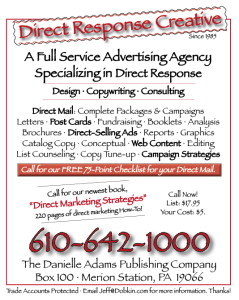The 3-Ad Myth – What NEVER TO DO when buying an ad at discount!
by Jeffrey Dobkin
When asked for a discount on a single ad insertion (publishers get this all the time), most magazine sales personnel reply, “You know, your ad has to be seen three times before you get the best response. Why don’t you place your ad three times and get the three-time rate?” And there lies the three-ad myth.
What usually happens? The advertiser says OK, buys three consecutive months of ads – say January, February, and March – and holds his breath.
Suppose ads cost $850 each (or $8,500 each… it doesn’t matter.) January comes and goes, and so does the advertiser’s money. Total sales income: $220. Now the myth kicks in. February comes. Total sales income: $350. Better? Yes. Good enough to cover the cost of the ads? Not nearly, not even close. If the advertiser is lucky, a few additional orders straggle in from January’s ad: + $60, which still sucks. March’s ad breaks, more dim sales, $375. Ugh. Are we having fun yet?
Sure, repeated exposure may get you more sales, but if your ad isn’t working enough to draw ants at a picnic, face it: it’s tanking and probably won’t be enough to cover the ad placement costs. The ONLY place the three consecutive month ads placement MAY work is if your ad revenue is very very close to breaking even with your first ad, then the second two ads MAY be profitable. But over the past 25 years or so that I’ve been involved in advertising, I have never, ever seen a first ad draw poorly – like in the above first example – and then BOOM: make money in the second ad, then become really profitable for the advertiser the third ad. Never.
It’s a little thing the magazine publishers never tell you:
If your first ad doesn’t work, your next ad will double your loss in advertising expense. Yes, the two ads combined will now lose more money for you. Then your third ad will cost you three times as much as the first. Even if your revenues go up, it will probably only be by a fraction of what you need to cover cost of the ad placement. OK, I’ll throw in the benefit of the doubt – suppose your revenues go up a full 20%. Grrreeeat! You still lost money with that ad placement strategy. Would you like to bet against my 25 years of practical experience with your 3-ad insert, knowing those odds?
Advertising: Ad Negotiation — How to really buy 3 ads at a discount
So, you’re sure your untested and and that untested magazine will work for you… OK. Go ahead, buy three ads and claim your 3-ad discount. Schedule the first ad placement at your discretion, and I’d go with the strongest month for possible sales. If your ad doesn’t work in your strongest sales month, sure ain’t gonna work in the weakest placement month, is it?
Here’s the kicker: specify in your insertion order for the second of your three ads to run at least four months after the first one appears in the magazine. Reason: if the first ad is a flop, you’ll have TIME TO CANCEL the second and third ads before it’s too late to cancel them.
Most larger publishers compose their magazines, layout and send the galleys to their printer two or three months before they are ready to be mailed. This long lead time makes it virtually impossible to place an ad in an issue just coming out, but more importantly, it makes it impossible to cancel an ad during this three-month period (or at least that’s the story you get when you ask a publisher to cancel next month’s ad.) So if your first ad appears in January, by the time this issue hits the streets, February and March issues are most likely in final design stages, at the printer’s, or maybe even printed. It may be too late to cancel your ad and you probably won’t have much help from the publisher, he would face leaving a large white space where your ad was going to run on page 147 of his next magazine.
Here’s what to do: contract with the publisher to run the first ad in January (or any month you think it will draw the best response). To get the three-time rate, schedule the second and third ads in 6 months – as in our example, use the June and September issues. Keep in mind YOU HAVE A YEAR TO FULFILL THE CONTRACT with the insertion of the other two ads.
Sure, the continuity will be broken, but if your ad fails, your lesson will only cost you 1/3 as much. Because now you’ll have time to cancel the next two ads. Yes, you’ll have to pay the difference between the one-time placement charge and the three-time placement charge, but hellllllooooo… it’s a lot cheaper than paying for two more ads. A LOT cheaper.
As you can see, I don’t care for the publisher’s miss-statement: “You need to run an ad three or more times for credibility.” While there is a certain truth to building trust and credibility with multiple exposures, an ad that falls flat on its face the first time it appears in a newspaper or magazine is still going to lose money the second time the ad appears, and the third time the ad is inserted. Period. And I’ll guaran-damn-tee that.
What if the first ad works?
Wow – you’re one of the few. Now ask the publisher how soon you can place another ad. Since this is the revenue stream for every publishing company, you’ll have the publisher, every space salesperson, the graphic designer, the layout artist and the printer at the magazine all pushing as hard as humanly possible to get your ad in the next issue. It’s money to them. Rest assured, the whole publication staff will now work as hard as possible and focus to get your ad included in the earliest issue possible.

Jeffrey Dobkin
With this little scheduling trick, for every ad test that fails you’ll be able to cancel your second and third ads in time. You’ll save 2/3 of your money. Now, send me 1/3, and this lesson still saved you 1/3. No dice? Heck, for hundreds of other insider’s tricks at least buy a few of my books, How To Market a Product for Under $500! or Uncommon Marketing Techniques. Thanks.